~~* Black Sheep Newsletter............Issue 130............Winter 2007 *~~
 †
†
THE HOMESTEAD: Helicopters, Coho Salmon and Fixing It
The helicopter hovered over our property's largest meadow and I stood at a distance of hundreds of yards near the barn watching, alongside a few of my neighbors. One of those neighbors brought along two plastic lawn chairs. I sat in one which she let me use and she sat snugly in the other.![]()
Our angora goat herd watched from their own distance behind locked gates. I noted that all their heads were tilted the direction of the noise and they watched with intense concentration the flight of the mechanical bird.![]()
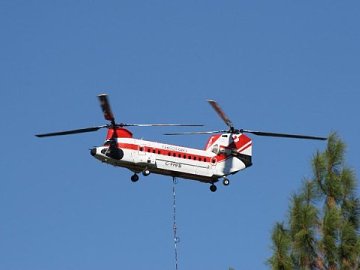
Columbia Helicopter Viet Nam era Chinook
Its engine was as loud as a freight train's rumble, even from afar. Its expansive blades whirled above it, creating a hurricane-like wind. Even from a distance I could see trees swaying and bending from that wind. Like a gigantic "crop circle" in a Kansas corn field, the grasses and trees below flattened out. The helicopter stood still in the air like some kind of giant dragonfly and carefully lowered the long line attached to metal grapples. In turn, those grapples took up the huge logs by weighted bundles and slowly maneuvered them into the dry creek bed.![]()
This was the day long awaited, long forecast on our calendar, when the huge Columbia Helicopter Company Chinook would move large precut wood logs into Joe Hall Creek, our homestead creek. My husband was invited to move close to all the action by the pilot of the craft, and with a bit of trepidation I watched Stan put an orange hard hat atop his head, get in a pick up with one of the foresters in charge of the project, and drive toward the open meadow. He had a smile on his face that wouldn't quit.![]()
This writing is long overdue, though my husband has kept a running journal of our attempt to accommodate the returning runs of Coho salmon who decided on their own to return to the Joe Hall Creek after a hiatus of 50 or more years. You can find the "whole story" on our website (www.singingfalls.com) where Stan has done a pretty good job of telling it. Maybe I'll call this "my side of the story."![]()
My Side of the Story
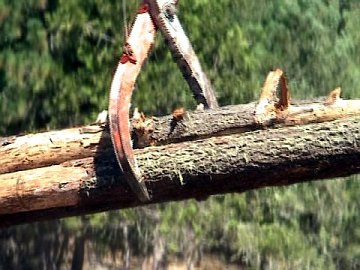
Grapples hanging on a 250 foot cable
It was September and the rains had not yet come to inundate this good land even as they are doing as I write, good soaking guff drenching Oregon rain, as I like to call it. The creek bed was still very dry and the water had all but disappeared from its rocky bed, only to be seen here and there in small, diminishing pools. The summer sun had dried up the creek yet again. Overhead, as we sat on our lawn chairs next to the barn's hayloft, the an orb of sun beat mercilessly. The chairs sat under a tall Douglas pine and its shade was comforting.![]()
Old timers spoke of Joe Hall in the days before as being not a seasonal creek but rather a deep running body of water that flowed all year round. One guy, a Cow Creek Indian tribal member now in his early 70s who had grown up right here said that when he was a boy he would swim in the deep pools that were still a part of Joe Hall. "You want to know how deep some of those holes were?" he asked my husband one day. "I rode horses in those days. Me and my horse, we'd jump in and would have to swim across in many places of this watershed." Sadly, those kinds of "holes" no longer existed.![]()
After the coho miraculously, it seemed, "came back" to Joe Hall Creek after so long a sojourn away, my husband and I as property owners, decided that maybe there was a part we could play in the long range scheme of things. When those coho returned and began building their "redds" (nests) two Decembers ago, this goat farm became the habitation of an assortment of two legged creatures soon enough. The U.S. Forest Service sent a few of its employees our way and together, eye to eye, we determined – all of us – that we'd do all we could to see that the silver backed salmon would keep returning to Joe Hall year after year. We'd do all in our power, that is. Most of the real work was indeed, as always, up to nature and her own devices.![]()
The first thing Stan and I did was lease 12 acres of land surrounding our creek to implement this project. It's a ten-year lease and our part is to keep our livestock fenced from the riparian zones.![]()
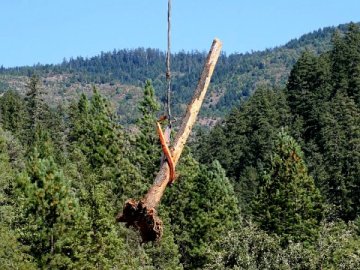
21,000 pound log with attached root wad
It was that same Indian I mention above that said in the "old days" a man could walk across the creek on the backs of the fish as they migrated upstream from the cold, salt laden ocean to the west. The 260 plus miles they had come could be tallied on a map, but what those fish endured and how many obstacles they'd jumped over and swam through could never be told. Only a few make it back to "home" after their sojourn in the northwest Pacific Ocean. And of those few, we were awestruck that some had decided to migrate all the way back to a land they'd forgotten for more than half a century. There they were again, the big fish, in our very backyard.![]()
This is an ongoing story, spectacular and unfolding daily for us. Last week as the Oregon mists curled above me in the mountains surrounding my home, like smoke being blown from a vast pipe somewhere, I veered from the barn to the creek on the other side of the property. Anticipation reigned and I wanted to see if the redds were being made again this winter. Stan had been making a daily trek to the stream banks and said that any day the coho might return. I wanted to see one of those big fish churning up the gravel just as I had last year. Yet we knew that it was possible they would not return this winter. Already very late in the migration season, to the date of this writing none have been spotted.![]()
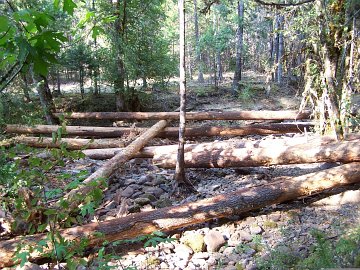
Large wood placement weir
We teased that perhaps all those 55 foot long towering logs with their root wads still clinging fitfully to them and placed in zig-zag fashion along the creek bed like so many pick up sticks caused the fish some consternation in their return trip. "Things have changed," the salmon said to one another, looking askance at man's intrepid efforts to bring them back.![]()
Indeed, the log and boulder placements were our attempts at mimicking nature to somehow slow those rushing and turbulent waters as they journeyed to the ocean. We succeeded in creating quiet pools with graveled eddies for the fish to make their nests. However, the fish as of this date, January 3, 2007, have not come back. Have our "plans" failed? Was all the hard work and planning along with the placement of heavy logs and rock weirs totally for naught?![]()
"That seems normal enough," explained Casey Baldwin, chief fish biologist for the Tiller Ranger District here in Tiller, Oregon. "They'll come back two years in a row and then on the third year they'll miss coming back. We'll no doubt see them next year..." He explained that with the coho there is a three-year "cycle." The baby coho born the first year here should be making a return trip next winter.![]()
I'm hoping that's the case, of course, because now that we've come this far with the 'coho project' on our homestead, we are all hoping for a successful outcome. We may never again see holes deep enough for a man on his horse to swim across, but perhaps – just perhaps – the coho will come back in vast droves, and someday I'll tell you how they are walking across Joe Hall on the backs of a hundred silver salmon...![]()
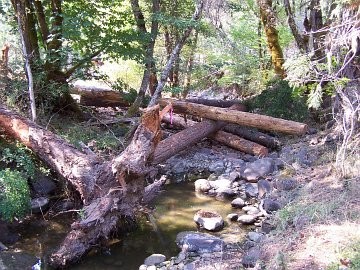
Large wood placement weir
Spring's Arrival Around the Corner
...and back to the ranch, as they say. I see that the green tops of the daffodils are poking up out of the Oregon mud, as are the green spikes of narcissus. Some of them are already showing swollen green heads. There is a vast gathering of these early spring flowers planted along the walkway that lead to the front of our cottage. They bloom during the early part of March, their upturned faces all white. The lamp post they surround still holds a hand carved swinging sign, something like the carven wood sign that signaled Tolkien's famed inn, The Prancing Pony.![]()
Our sign, in turn, says, "Mo's Harem." It was the first name we chose for our cottage industry years ago when this old cottage first became ours. "Mo" was our first Angora buck and thus the name. In small letters under those two words my husband carved "Mohair – Natural Fiber Cottage Industry." The angora goat head needs another coat of paint, I see. When spring's warmth takes away this chill air, I'll try to do it.![]()
I note that more than the tips of spring flowers are swelling. Day before yesterday I walked amidst the Suffolk sheep and noticed that two or three of the girls have very swollen bellies and are a bit puffy in the back end. Already? I ask myself in disbelief. Yes, according to the calendar, the big ram began his task in nature's cycle at the end of August. Little lambs should be hitting the ground at the end of January.![]()
I'll keep an eye out. Last year I lost one lamb that was dropped by an eager but rather uneducated first timer, a small ewe who dropped him into a deep mud puddle on the road. I found the cold wet body later and was sad that I missed it this time. It was too late when I saw her standing there in the rain all by herself. A ewe standing off by herself is always a "signal" that birth is imminent. Usually I am aware, seeing all the "signs", days before they give birth and I'm prepared and at the ready.![]()
That cold January day I took up the tiny body from the puddle and it lay in my hands icy cold. The ewe looked up at me then and plaintively cried. I hate hearing the sadness of an animal that loses its young. It happens every year, and every year like the author Jon Katz ("The Dogs of Bedlam Farm"), I say "not this year. I won't lose any lambs or kids this year." But it happens, nonetheless. I lose one or two.![]()
Nature can be quirky at times, but it's all part of shepherding and goatherding and I always have to pull up my bootstraps, slosh through the mud and put some more duct tape around holes in my mud boots. Remember to buy a new pair next spring – these holes are gigantic! The cycles of nature are sometimes predictable and sometimes not.![]()
The next day I was more vigilant. It was another first-time mother and she was pushing with all she had in her to deliver her young. The lamb didn't want to budge and seemed locked securely inside her. I grimaced as the young ewe stretched and strained and finally laid out flat on the ground while turning nearly upside down to get rid of her too big cargo. It would have been funny if it were not such a difficult birth.![]()
I called to my husband so that it was now the two of us. Would we have to pull the lamb? Stan was good at that. He'd delivered a few big goat kids in the past and I always left it up to him for the task.
We made no move yet and it became easier for her suddenly. Finally the lamb plopped onto Oregon ground. Simultaneously, a tired mom ran away from her lamb hardly looking back.![]()
Perhaps nature would have intervened (as she so often does) and all would have been well if we would have kept our distance. Mama would have circled back when she heard the cries, perhaps. We were not going to take any chances, however, recalling the little drowned lamb from the day before.![]()
We scooped up the newborn and brought the ewe with her lamb into a secluded pen inside the barn that had been made ready. The hay was deep and sweet; a heat lamp provided warmth and light. January's gloom was suddenly altered immeasurably by the gracious help of southern Oregon's electric company.![]()
We sighed a sigh of relief when the large-headed lamb began to suckle. In no time my small first timer began to accept his presence with enormous delight. So this is what it was all about, she suddenly seemed to be thinking while she grabbed up large mouthfuls of green hay...![]()
Late January - and none of the angora goats would be dropping their kids until early March, so it was interesting to note the many expectant goat mothers huddled around the pen watching the new arrival. They peered through the log struts with intense curiosity. I could almost hear their whispers:![]()
"It's a boy, I think," said one.![]()
"Hold on, hold on," chimed in another. "That's just a long bit of umbilical cord you see. It may be a girl after all..."![]()
Another coughed and continued to chew cud. "Wait until it pees," she said, with great authority. "Then you'll know one way or another. If she squats, she'll be a girl for sure. Wait. Yes, see that? He's standing and peeing. It's a boy after all. A big boy..." her voice trailed.![]()
Ah, yes, spring is around the corner, indeed, though it is only the beginning of January. I get so excited this time of year when everything begins to swell. Soon enough I am thinking I can hear the animals talking...now, how silly can that be?![]()
Good lambing and kidding to you (and good fishing, too!)![]()
Alexandra Scribe
Homestead Home
TOP






